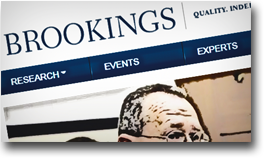The Brookings Institution recently released a report on the geographic distribution of workers using H-1B visas. (My colleague David North attended the press event for the report, which he discussed here.) The report itself is rather benign and presents no surprises to anyone familiar with the H-1B data. H-1B workers are highly concentrated in certain metropolitan areas.

My objection is not to the report itself, but rather the spin its authors and Brookings have put on it that cannot be justified by the report.
Let me give a little background information that sets up the issue. The fundamental problem for everyone who wants to look at the H-1B program is the poor reporting of data. USCIS compiles an annual report on H-1B visas summarizing its data and it produces lists of top H-1B users from time to time. Unfortunately, the only detailed raw data available is from the Department of Labor's disclosure of Labor Condition Applications (LCAs).
An LCA is the first step in the H-1B application process. The employer reports the type of job, work location, and prevailing wage on the LCA. LCAs are a good measure of employer prevailing wage claims. However, there are a number of issues that make it difficult to project the LCA data into the H-1B population:
- An LCA can specify multiple workers. Employers can use a single LCA for multiple visa applications.
- An LCA must be filed for each location where an alien will work.
- It costs nothing to file an LCA, so employers can file LCAs defensively. Employers submit approved LCAs with the actual visa applications.
In 2011, there were
The Brookings authors measured LCAs to calculate H-1B distribution. The report notes some (but not all) of the problems that this causes to accuracy.
Let me illustrate the LCA-to-visa problem. The Brookings report (Table 1) says that Microsoft is the top H-1B user, making an average of 4,109 "requests" from 2010–2011. In contrast, data from USCIS for 2011 show that Microsoft was sixth in visa usage, with 1,586 visas approved. Brookings places Cognizant at sixth with an average of 2,107 visa "requests", while USCIS says that Cognizant was first with 5,715 visas.
The source of the discrepancy is that Cognizant's LCAs are generally for 20 or 25 workers while Microsoft's LCAs only specify one worker.
This issue does not discredit the Brookings study. Brookings, like everyone else, has to work with the data that are available. The data limitations cause a loss of precision. There is no problem if you interpret the Brookings report as saying Microsoft and Cognizant are among the largest users of H-1B visas.
You can view the location data the same way. If there are 1,000 LCAs specifying one city as the work location and 100 for a second city, it is highly likely more H-1B workers are going to the first city than the second city. There are some discrepancies between the Brookings geographic rankings and rankings derived from visa data, but the Brookings report gives a valid qualitative view of where H-1B workers are more likely to be found.
Brookings needs to be called out on is its spin of its report, however. This clearly was intended beforehand. The Brookings report calls a "Labor Condition Application" an "H-1B visa request" throughout, giving the impression that they were measuring the number of visa applications made. The authors subsequently have been spinning the LCA numbers to make it appear that the visa demand exceeds supply by a wide margin.
Here is an example of how the authors use that substitution for effect:
Brookings fellow Neil Ruiz said that demand for visas outpaces supply by a huge margin. He estimates there are about 300,000 requests annually for just 85,000 H-1B visas, which are issued on a first-come, first-served basis starting in April.
In reality, the 300,000 "requests" are for the 1) 85,000 visas under the quota, plus 2) all of the visas not covered by the quota, 3) all of the renewals, 4) all of the visa transfers, and 5) all of the extra LCAs needed for multiple work locations.
Instead of 300,000 "requests" for 85,000 visas it is really 300,000 "requests" for at least 269,653 visa applications in 2011 (plus transfers, renewals, and extras; minus duplicate workers on the LCAs).
The report's author states:
Our new research found that the demand for H-1B workers spans industries, metropolitan areas, and a wide range of occupations, and over two-thirds of all requests for H-1Bs are for STEM jobs — the positions that are hardest to fill by employers.
The LCA data say nothing about how hard it is to fill a particular job. The study has no evidence that STEM jobs are harder to fill than any others.
In conclusion, Brookings authors have taken a report on the relative distribution of H-1B workers and are trying to spin it into a report on demand for visas and jobs, something that is completely unsupported by their data.
